Analysis and Processing of Nadir and Stereo VHR Pleiadés Images for 3D Mapping and Planning the Land of Nineveh, Iraqi Kurdistan
Abstract
:1. Introduction
1.1. State of the Art
1.2. Description of the Study Area
2. Materials and Methods: Documenting the Whole Archaeological Park
- Pleiadés VHR images processing, used for a visual interpretation of the study area, together with a general overview of the entire Archaeological Park;
- Stereo-pair processing, used for obtaining the DEM of the area, useful to study in detail the morphology of the area of Khinis.
2.1. Pleiadé VHR Images Processing
2.1.1. Dataset
2.1.2. Images Processing
2.2. Stereo-Pair Imagery Processing
2.2.1. Dataset
2.2.2. DEM Extraction
3. Results
4. Discussion and Conclusions
Acknowledgments
Author Contributions
Conflicts of Interest
Abbreviations
| RS | Remote Sensing |
| DEM | Digital Elevation Model |
| SRTM | Shuttle Radar Topography Mission |
| GIS | Geographical Information System |
| VHR | Very High Resolution |
| HVS | Hue Value Saturation |
| G–S | Gram–Schmidt |
| PC | Principal Components |
| GCP | Ground Control Point |
| WHTL | World Heritage Tentative List |
| GNSS | Global Navigation Satellite System |
References
- Malinverni, E.; Barbaro, C.C.; Pierdicca, R.; Bozzi, C.; Tassetti, A. UAV surveying for a complete mapping and documentation of archaeological findings. The early Neolithic site of Portonovo. Int. Arch. Photogramm. Remote Sens. Spat. Inf. Sci. 2016, 41, 1149–1155. [Google Scholar] [CrossRef]
- Laet, V.D.; Paulissen, E.; Waelkens, M. Methods for the extraction of archaeological features from very high-resolution Ikonos-2 remote sensing imagery, Hisar (southwest Turkey). J. Archaeol. Sci. 2007, 34, 830–841. [Google Scholar] [CrossRef]
- Forte, M.; Campana, S. Digital Methods and Remote Sensing in Archaeology: Archaeology in the Age of Sensing; Springer: Berlin, Germany, 2017. [Google Scholar]
- Hadjimitsis, D.G.; Agapiou, A.; Themistocleous, K.; Alexakis, D.D.; Sarris, A. Remote sensing for archaeological applications: Management, documentation and monitoring. In Remote Sensing of Environment-Integrated Approaches; Hadjimitsis, D.G., Ed.; InTech: Rijeka, Croatia, 2013. [Google Scholar]
- Orlando, P.; Villa, B.D. Remote sensing applications in archaeology. Arch. Calcolatori 2011, 22, 147–168. [Google Scholar]
- Castrianni, L.; Giacomo, G.D.; Ditaranto, I.; Scardozzi, G. High resolution satellite ortho-images for archaeological research: Different methods and experiences in the Near and Middle East. Adv. Geosci. 2010, 24, 97–110. [Google Scholar] [CrossRef] [Green Version]
- Malinverni, E.S.; Tassetti, A.N.; Mancini, A.; Zingaretti, P.; Frontoni, E.; Bernardini, A. Hybrid object-based approach for land use/land cover mapping using high spatial resolution imagery. Int. J. Geogr. Inf. Sci. 2011, 25, 1025–1043. [Google Scholar] [CrossRef]
- Parcak, S.H. Satellite Remote Sensing for Archaeology; Routledge: Abingdon, UK, 2009. [Google Scholar]
- Di Giacomo, G.; Scardozzi, G. Multitemporal high-resolution satellite images for the study and monitoring of an ancient Mesopotamian city and its surrounding landscape: The case of Ur. Int. J. Geophys. 2012, 2012. [Google Scholar] [CrossRef]
- Malinverni, E. DEM automatic extraction on Rio de Janeiro from WV2 stereo pair images. IOP Conf. Ser. Earth Environ. Sci. 2014, 18. [Google Scholar] [CrossRef]
- Krauß, T.; Lehner, M.; Reinartz, P. Generation of coarse 3D models of urban areas from high resolution stereo satellite images. Int. Arch. Photogramm. Remote Sens. 2008, 37, 1091–1098. [Google Scholar]
- Perko, R.; Raggam, H.; Gutjahr, K.; Schardt, M. Advanced DTM generation from very high resolution satellite stereo images. ISPRS Ann. Photogramm. Remote Sens. Spat. Inf. Sci. 2015, 2. [Google Scholar] [CrossRef]
- Shean, D.E.; Alexandrov, O.; Moratto, Z.M.; Smith, B.E.; Joughin, I.R.; Porter, C.; Morin, P. An automated, open-source pipeline for mass production of digital elevation models (DEMs) from very-high-resolution commercial stereo satellite imagery. ISPRS J. Photogramm. Remote Sens. 2016, 116, 101–117. [Google Scholar] [CrossRef]
- Casana, J.; Cothren, J. Stereo analysis, DEM extraction and orthorectification of CORONA satellite imagery: Archaeological applications from the Near East. Antiquity 2008, 82, 732–749. [Google Scholar] [CrossRef]
- Berthier, E.; Vincent, C.; Magnússon, E.; Gunnlaugsson, Á.; Pitte, P.; Le Meur, E.; Masiokas, M.; Ruiz, L.; Pálsson, F.; Belart, J.; et al. Glacier topography and elevation changes derived from Pléiades sub-meter stereo images. Cryosphere 2014, 8, 2275–2291. [Google Scholar] [CrossRef]
- Bagnardi, M.; González, P.J.; Hooper, A. High-resolution digital elevation model from tri-stereo Pleiades-1 satellite imagery for lava flow volume estimates at Fogo Volcano. Geophys. Res. Lett. 2016, 43, 6267–6275. [Google Scholar] [CrossRef]
- Parmegiani, N.; Poscolieri, M. DEM data processing for a landscape archaeology analysis (Lake Sevan-Armenia). Int. Arch. Photogramm. Remote Sens. Spat. Inf. Sci. 2003, 34, 255–258. [Google Scholar]
- Vandenbulcke, A.; Stal, C.; Lonneville, B.; Bourgeois, J.; De Wulf, A. Using 3D modelling in the valley of Turu Alty (Siberia, Russia) for research and conservational purposes. In Proceedings of the 8th International Congress on Archaeology, Computer Graphics, Cultural Heritage and Innovation ’ARQUEOLÓGICA 2.0’, Valencia, Spain, 5–7 September 2016; Lerma, J.L., Cabrelles, M., Eds.; Universitat Politécnica de Valéncia: Valencia, Spain, 2016; pp. 408–411. [Google Scholar]
- Nasir, S.; Iqbal, I.A.; Ali, Z.; Shahzad, A. Accuracy assessment of digital elevation model generated from pleiades tri stereo-pair. In Proceedings of the IEEE 7th International Conference on Recent Advances in Space Technologies (RAST), Istanbul, Turkey, 16–19 June 2015; pp. 193–197. [Google Scholar]
- Sofia, G.; Bailly, J.S.; Chehata, N.; Tarolli, P.; Levavasseur, F. Comparison of Pleiades and LiDAR Digital Elevation Models for terraces detection in farmlands. IEEE J. Sel. Top. Appl. Earth Obs. Remote Sens. 2016, 9, 1567–1576. [Google Scholar] [CrossRef]
- Gleyzes, M.A.; Perret, L.; Kubik, P. Pleiades system architecture and main performances. Int. Arch. Photogramm. Remote Sens. Spat. Inf. Sci. 2012, 39. [Google Scholar] [CrossRef]
- Bernard, M.; Decluseau, D.; Gabet, L.; Nonin, P. 3D capabilities of Pleiades satellite. Int. Arch. Photogramm. Remote Sens. Spat. Inf. Sci. 2012, 39, 553–557. [Google Scholar] [CrossRef]
- Cantou, J.; Maillet, G.; Flamanc, D.; Buissart, H. Preparing the use of Pleiades images for mapping purposes: Preliminary assessments at IGN-France. Int. Arch. Photogramme. Remote Sens. 2006, 36. [Google Scholar]
- Šedina, J.; Pavelka, K.; Housarová, E. Archaeological documentation of a defunct Iraqi Town. Int. Arch. Photogramm. Remote Sens. Spat. Inf. Sci. 2016, XLI-B1, 1031–1035. [Google Scholar]
- Asăndulesei, A. Inside a Cucuteni Settlement: Remote Sensing Techniques for Documenting an Unexplored Eneolithic Site from Northeastern Romania. Remote Sens. 2017, 9, 41. [Google Scholar] [CrossRef]
- Jiang, S.; Jiang, W.; Huang, W.; Yang, L. UAV-Based Oblique Photogrammetry for Outdoor Data Acquisition and Offsite Visual Inspection of Transmission Line. Remote Sens. 2017, 9, 278. [Google Scholar] [CrossRef]
- Sonnemann, T.F.; Ulloa Hung, J.; Hofman, C.L. Mapping Indigenous Settlement Topography in the Caribbean Using Drones. Remote Sens. 2016, 8, 791. [Google Scholar] [CrossRef]
- Harrower, M.J. Geographic Information Systems (GIS) hydrological modeling in archaeology: An example from the origins of irrigation in Southwest Arabia (Yemen). J. Archaeol. Sci. 2010, 37, 1447–1452. [Google Scholar] [CrossRef]
- Parcak, S.H. GIS, Remote Sensing, and Landscape Archaeology; Oxford Handbooks Online; Oxford University Press: New York, NY, USA, 2017. [Google Scholar]
- Campana, S. Ikonos-2 multispectral satellite imagery to the study of archaeological landscapes: An integrated multi-sensor approach in combination with “traditional” methods. In Proceedings of the 30th Conference CAA, Heraklion, Greece, 2–6 April 2002; pp. 2–6. [Google Scholar]
- Pierdicca, R.; Malinverni, E.; Clini, P.; Mancini, A.; Bozzi, C.; Nespeca, R. Development of a GIS environment for archaeological multipurpose applications: The Fano historic centre. In Proceedings of the XIII International Forum Le Vie dei Mercanti, Lecce, Italy, 11–13 June 2015; pp. 588–597. [Google Scholar]
- Ur, J. Sennacherib’s northern Assyrian canals: New Insights from Satellite Imagery and Aerial Photography. Iraq 2005, 67, 317–345. [Google Scholar] [CrossRef]
- Bagg, A.M. Irrigation in northern Mesopotamia: Water for the Assyrian Capitals (12th–7th centuries BC). Irrig. Drain. Syst. 2000, 14, 301–324. [Google Scholar] [CrossRef]
- Bachmann, W. Felsreliefs in Assyrien: Bawian, Maltai und Gundük; Hinrichs: Leipzig, Germany, 1927. [Google Scholar]
- Jacobsen, T.; Lloyd, S. Sennacherib’s Aqueduct at Jerwan; University of Chicago Press: Chicago, IL, USA, 1935; Volume 24. [Google Scholar]
- Orazi, R.; Colosi, F. Archaeological Environmental Park of Sennacherib’s irrigation system (Iraqi Kurdistan). In Heritage and Technology. Mind, Knowledge, Experience, Proceedings of the Le vie dei Mercanti, XIII Forum Internazionale di Studi, Aversa, Capri, Italy, 11–13 June 2015; Gabardella, C., Ed.; Consiglio Nazionale Delle Ricerche: Roma, Italy, 2015; pp. 2021–2030. [Google Scholar]
- Lasaponara, R.; Masini, N. Pan-sharpening techniques to enhance archaeological marks: An overview. In Satellite Remote Sensing; Lasaponara, R., Masini, N., Eds.; Springer: Cham, Switzerland, 2012; pp. 87–109. [Google Scholar]
- Lasaponara, R.; Masini, N. Satellite Remote Sensing: A New Tool for Archaeology; Springer: Cham, Switzerland, 2012; Volume 16. [Google Scholar]
- Manakos, I.; Kalaitzidis, C. Imagin [e, G] Europe: Proceedings of the 29th Symposium of the European Association of Remote Sensing Laboratories, Chania, Greece; IOS Press: Amsterdam, The Netherlands, 2010. [Google Scholar]
- Liua, C.; He, G.J. Auto-matching algoritmh for Remote Sensing images. In Proceedings of the 4th International Conference on GEographic Object Based Image Analysis (GEOBIA), Rio de Janeiro, Brazil, 7–9 May 2012; p. 248. [Google Scholar]
- Pierdicca, R.; Frontoni, E.; Zingaretti, P.; Malinverni, E.S.; Colosi, F.; Orazi, R. Making visible the invisible. Augmented reality visualization for 3D reconstructions of archaeological sites. In Proceedings of the International Conference on Augmented and Virtual Reality, Ugento, Italy, 12–15 June 2016; Springer: Cham, Switzerland, 2015; pp. 25–37. [Google Scholar]
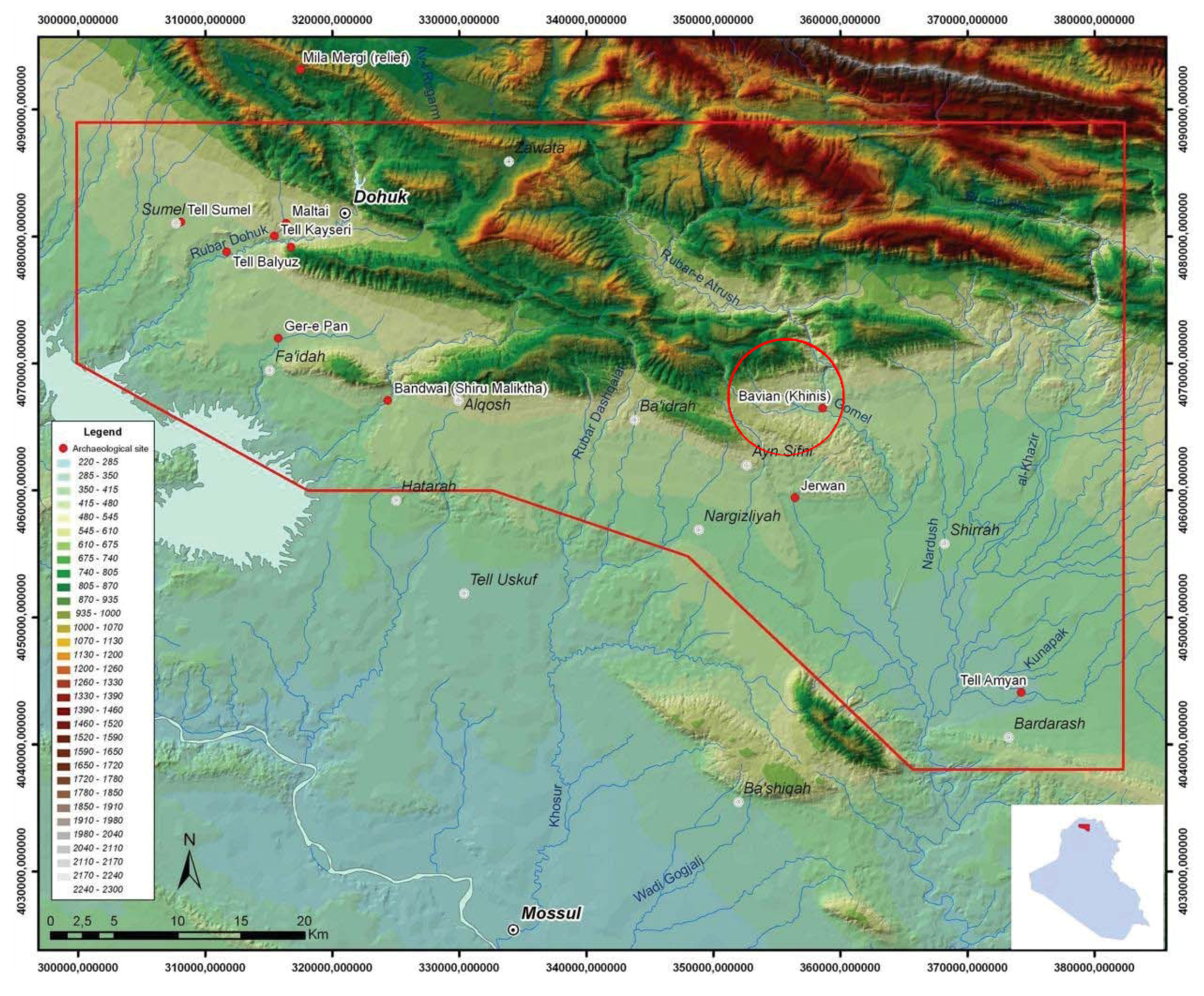
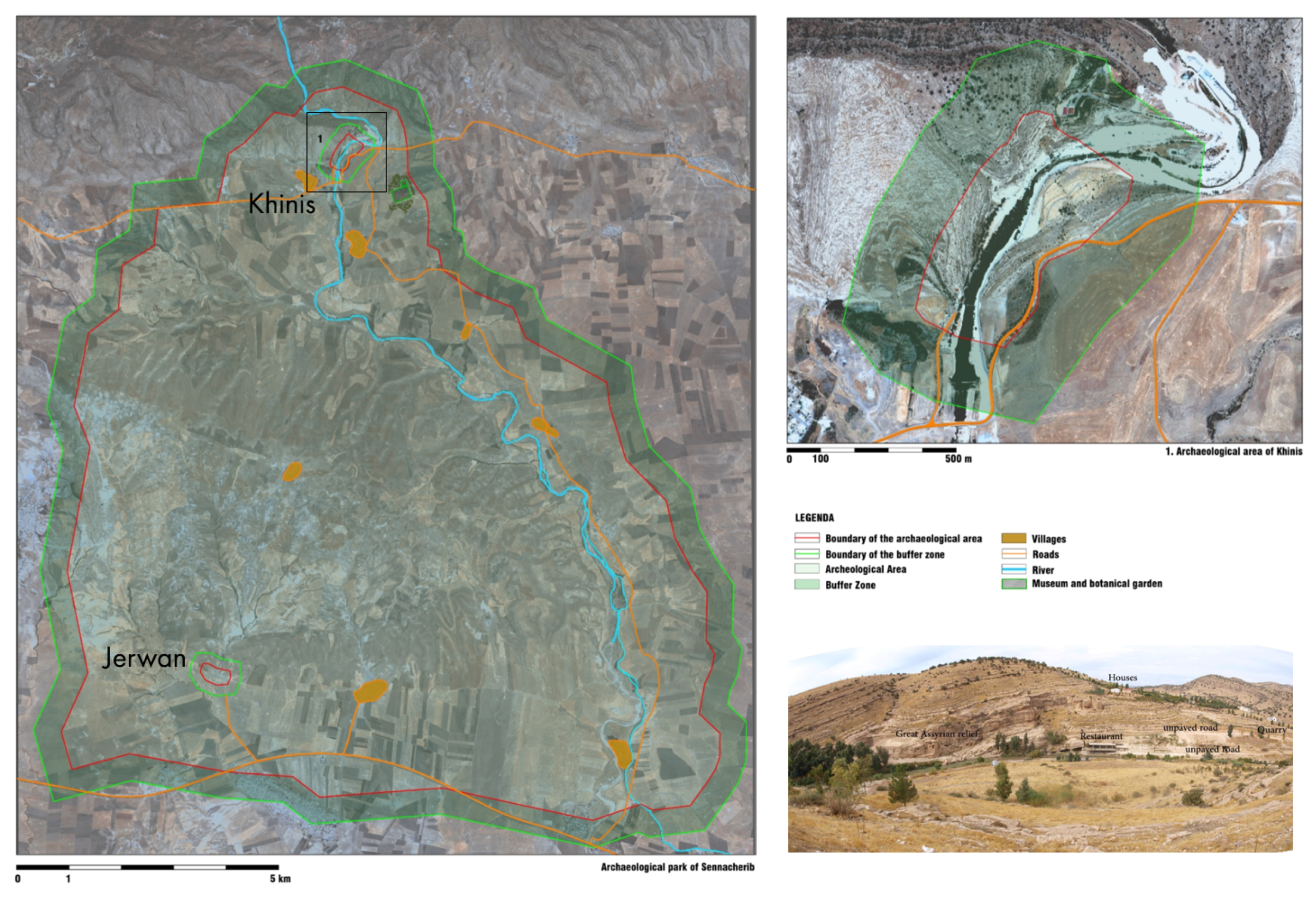
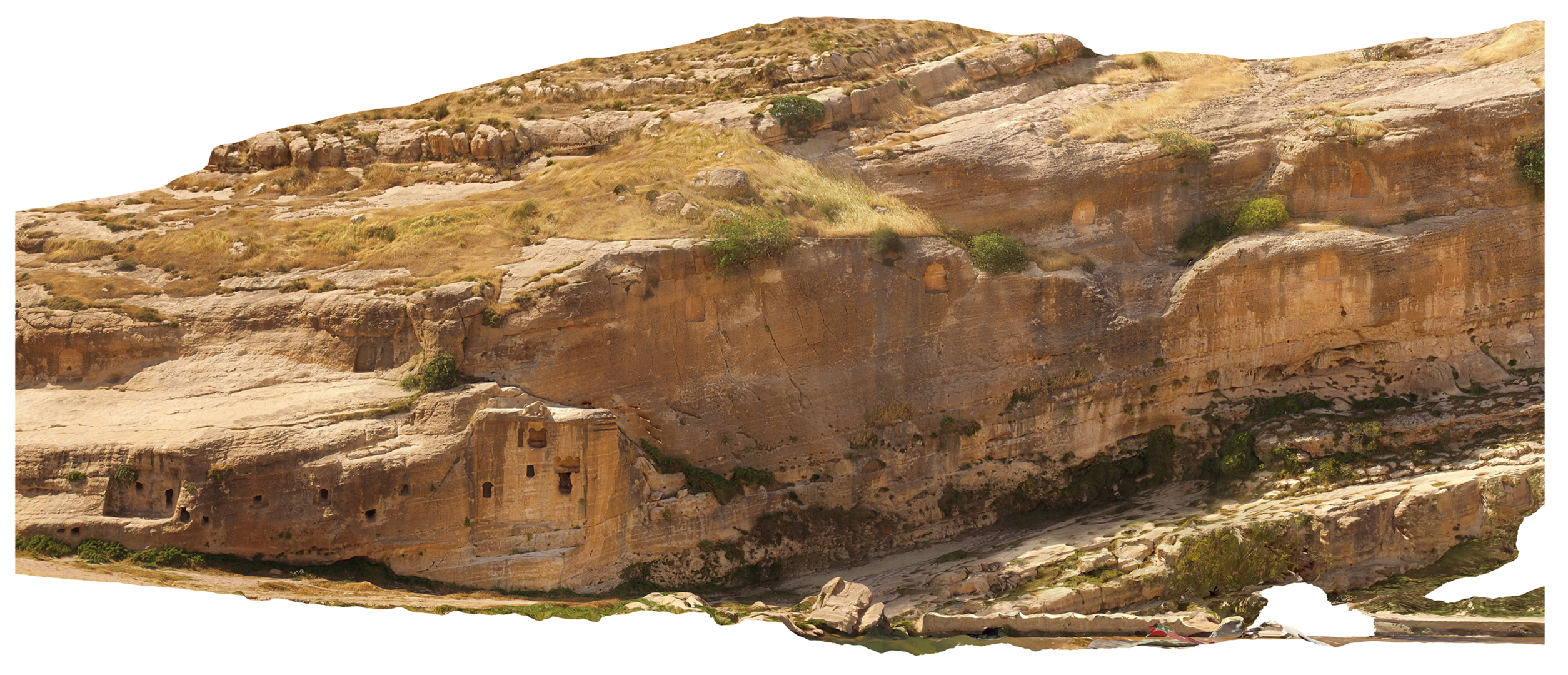
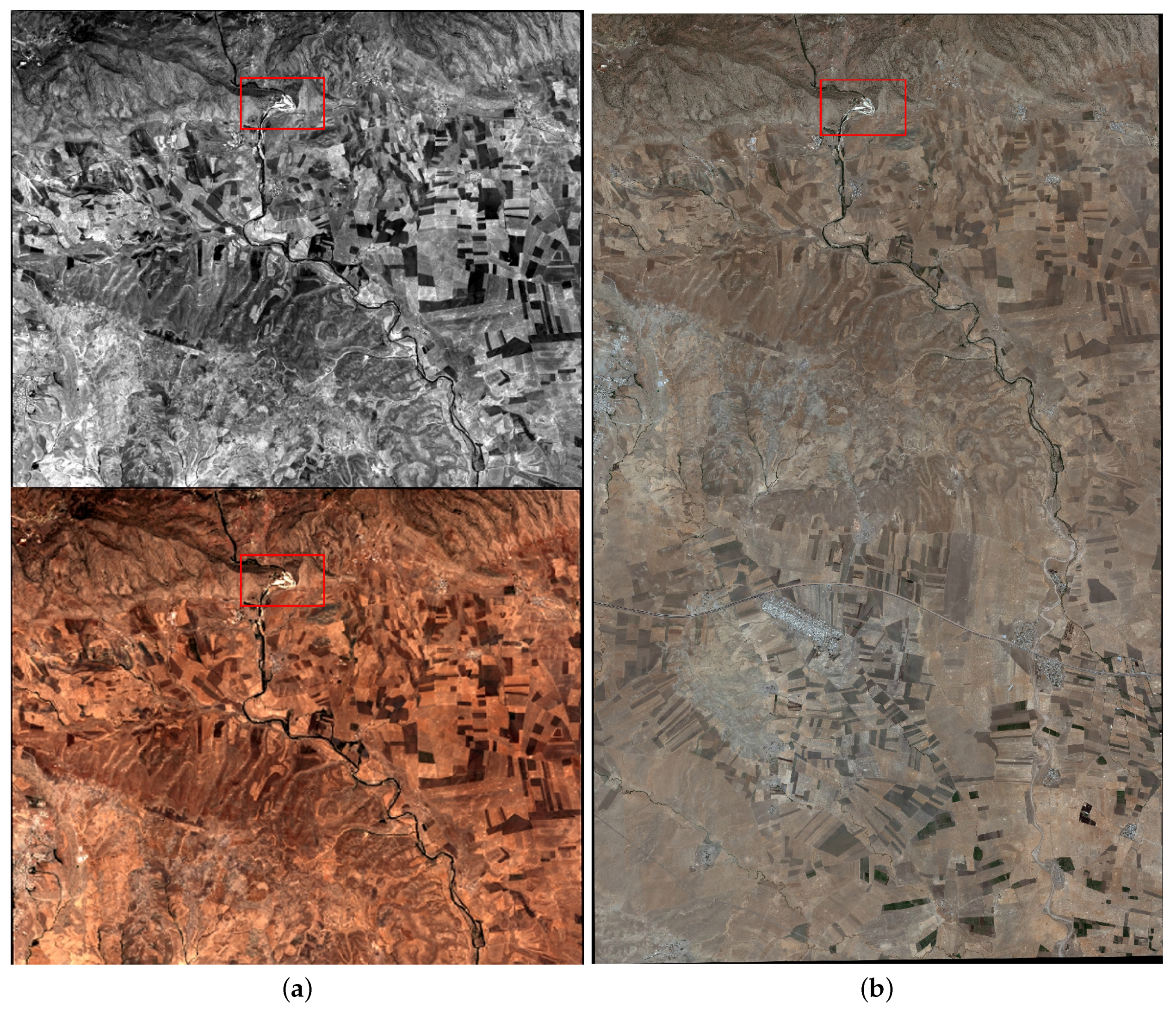

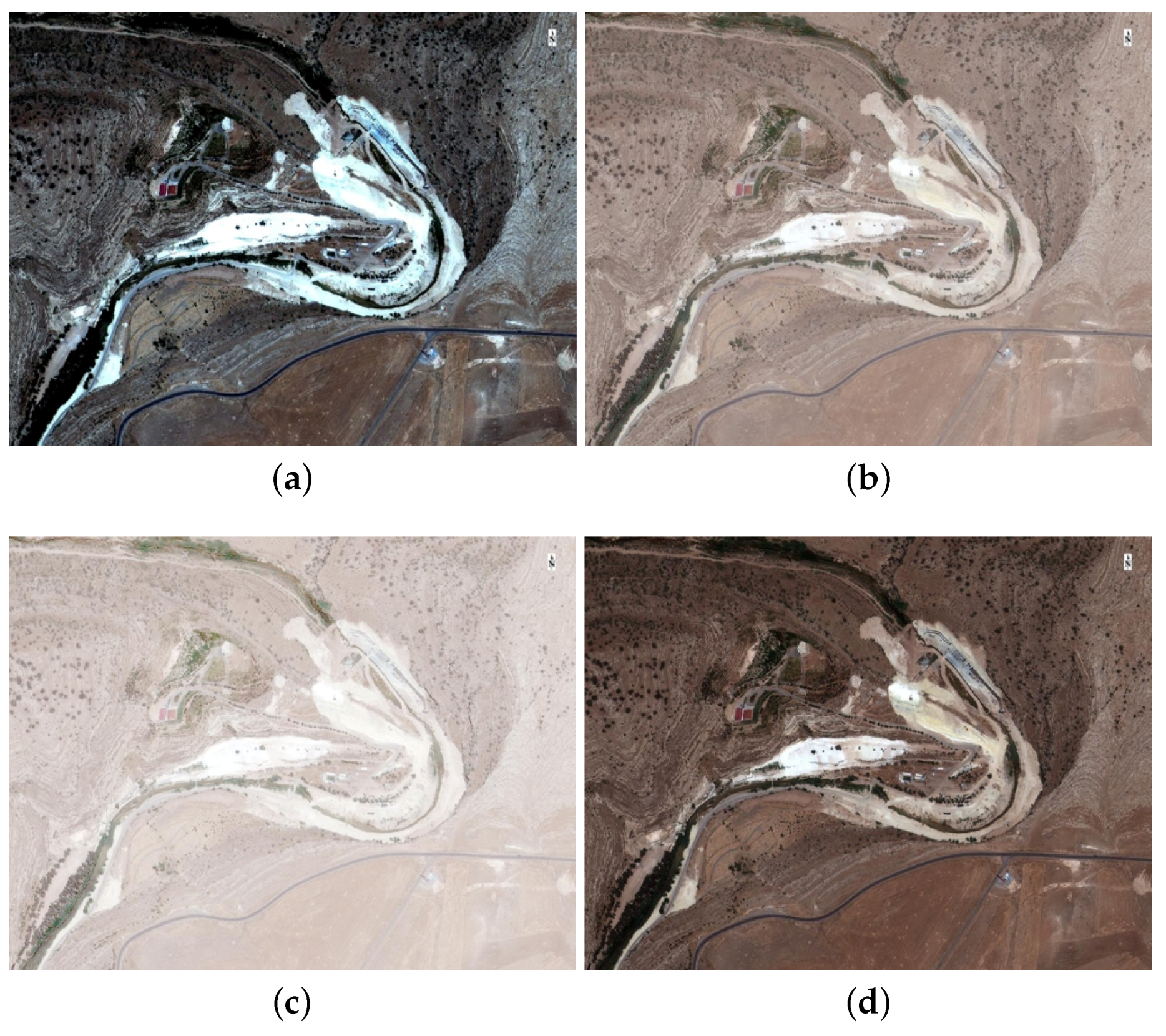

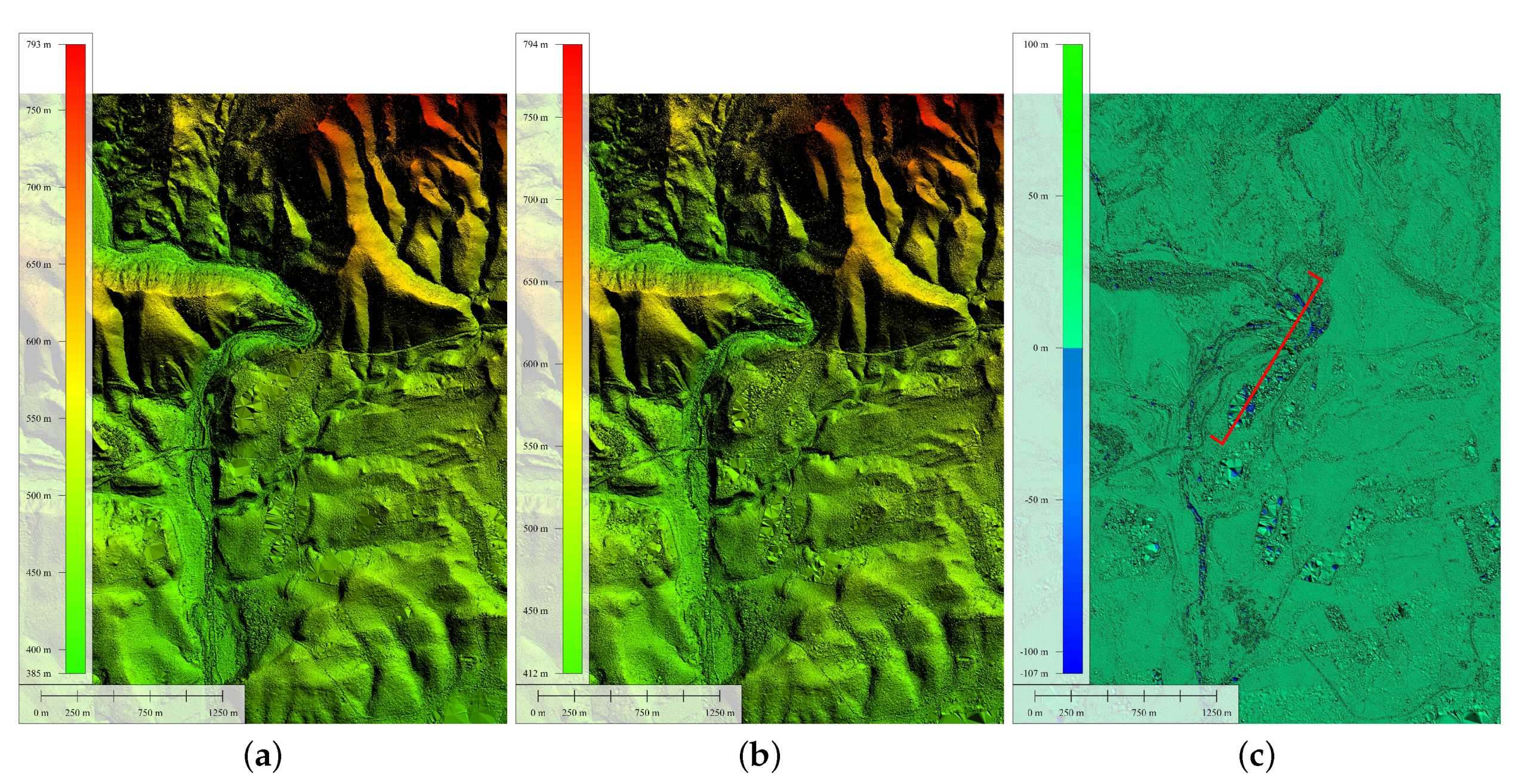

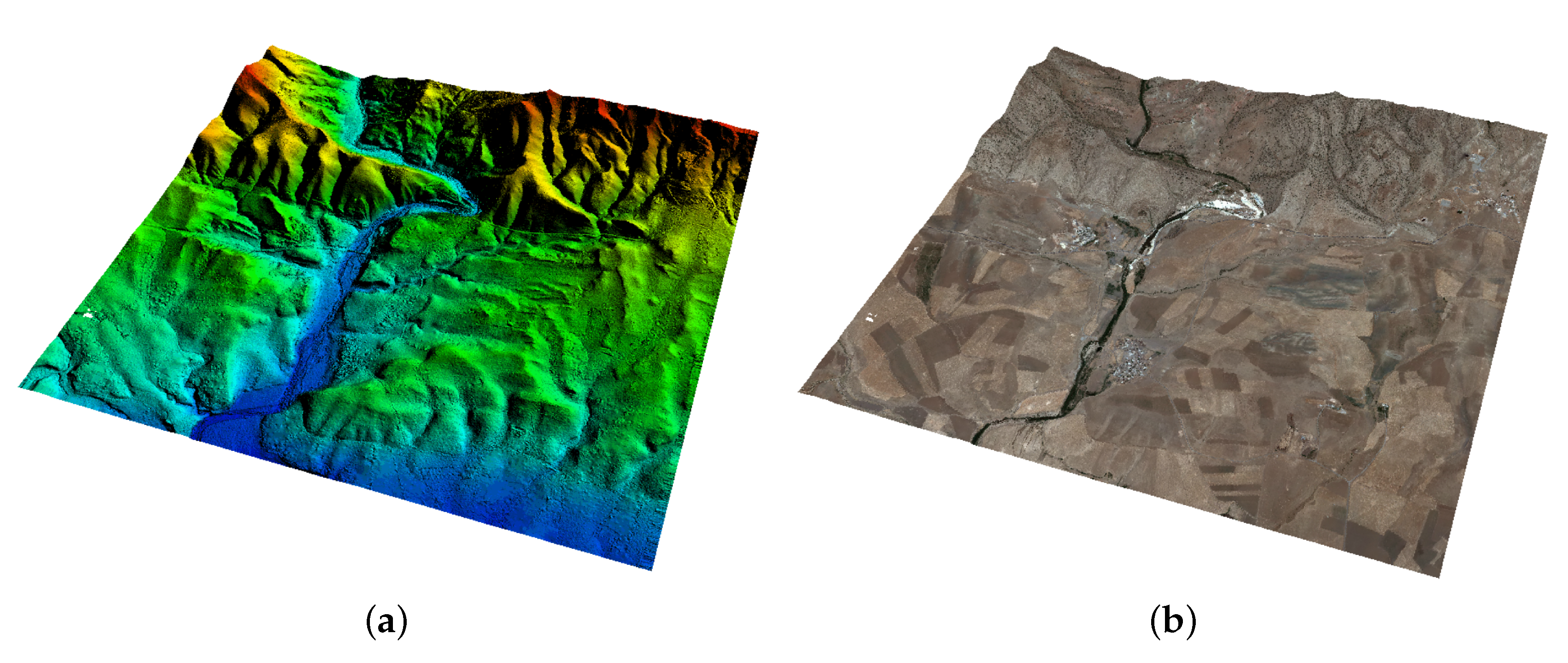

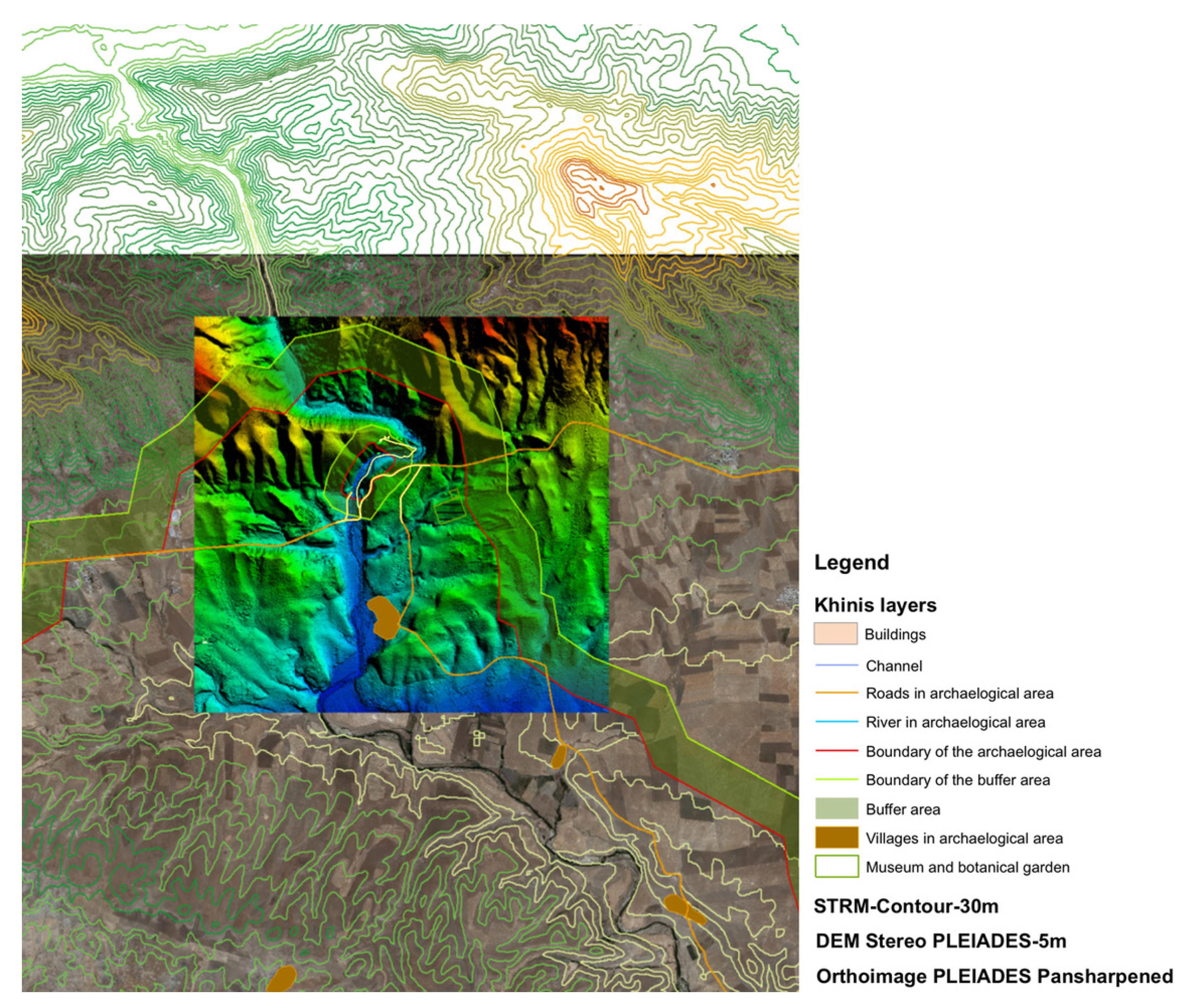
| Original | Hue, Saturation, Value | Principal Components | Brovey | Gram–Schmidt | |
|---|---|---|---|---|---|
| Mean | 111,721 | 106.473 | 120.683 | 103.687 | 120.496 |
| Variance | 66.107 | 69.795 | 64.667 | 65.506 | 65.090 |
| Mean (subset) | 127.834 | 126.668 | 140.149 | 123.126 | 123.364 |
| Variance (subset) | 71.078 | 77.913 | 71.787 | 74.438 | 77.037 |
| Image | Points | Iterations | Weighted Std Error (cm) | Residuals Max Value | Residuals Min Value |
|---|---|---|---|---|---|
| Panchromatic | 39 | 2 | 0.067 | 0.454 | 0.001 |
| Pansharpened | 37 | 2 | 0.126 | 0.424 | 0.009 |
| Image | Check Points | Standard Deviation | Root Mean Square Error | Matched Points | Output Points | Matching Quality |
|---|---|---|---|---|---|---|
| Panchromatic | 18 | 0.587 | 0.593 | 67362234 | 40156839 | Excellent: 92.7% Good: 7.5% |
| Pansharpened | 21 | 0.326 | 0.335 | 85901630 | 45195964 | Excellent: 91.1% Good: 8.9% |
© 2017 by the authors. Licensee MDPI, Basel, Switzerland. This article is an open access article distributed under the terms and conditions of the Creative Commons Attribution (CC BY) license (http://creativecommons.org/licenses/by/4.0/).
Share and Cite
Malinverni, E.S.; Pierdicca, R.; Bozzi, C.A.; Colosi, F.; Orazi, R. Analysis and Processing of Nadir and Stereo VHR Pleiadés Images for 3D Mapping and Planning the Land of Nineveh, Iraqi Kurdistan. Geosciences 2017, 7, 80. https://doi.org/10.3390/geosciences7030080
Malinverni ES, Pierdicca R, Bozzi CA, Colosi F, Orazi R. Analysis and Processing of Nadir and Stereo VHR Pleiadés Images for 3D Mapping and Planning the Land of Nineveh, Iraqi Kurdistan. Geosciences. 2017; 7(3):80. https://doi.org/10.3390/geosciences7030080
Chicago/Turabian StyleMalinverni, Eva Savina, Roberto Pierdicca, Carlo Alberto Bozzi, Francesca Colosi, and Roberto Orazi. 2017. "Analysis and Processing of Nadir and Stereo VHR Pleiadés Images for 3D Mapping and Planning the Land of Nineveh, Iraqi Kurdistan" Geosciences 7, no. 3: 80. https://doi.org/10.3390/geosciences7030080





